RISE & FALL OF THIPPAGONDANAHALLI DAM
Updated Date: 04 July 2022
This is the story of how the Thippagondanahalli dam/reservoir (a.k.a Chamarajasagara) on the Arkavathi river rose to prominence as Bengaluru’s drinking water source and 80 years later, became defunct because of pollution and loss of natural river flow. This is also the story of how the Arkavathi river which existed for millennia, was driven to death in the last 100 years.
With Arkavathi’s death, Thippagondanahalli dam just stood there as a testament to the wanton destruction of the very river that provided us with precious drinking water and not to mention the water for economic progress. While the Arkavathi river’s state of affairs has not changed, Thippagondanahalli dam’s has. It is being restored to hold water from Netravathi, a perennial river 280 kms away in the fragile western ghats. In essence, Thippagondanahalli dam switched rivers: From Arkavathi to Netravathi.
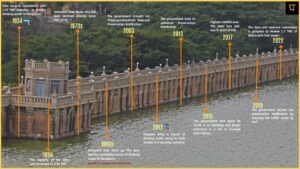
This detailed timeline narrative is critical to our understanding of how our handling of rivers has got us perilously close to running out of water. It shows how decisions to over-exploit the already strained rivers like Cauvery emerge. It also shows both-handedness: The silent and almost unnoticed death of the Arkavathi river and a bloodshed-ridden violent claim to Cauvery river water. This story serves as a constant reminder that whatever we have done and are doing, to protect and conserve the rivers, is clearly not enough.
A detailed profile of Thippagondanahalli Dam (also known as Chamarajasagara dam) can be found here.
Map of Arkavathi River Basin with Thippagondanahalli dam can be found here.

1934
Thippagondanahalli dam became operational.
With the drying up of Hesaraghatta Tank in 1922, and the failure of monsoons in 1925 and 1926, Bengaluru plunged into conditions of severe drought (1). To augment the dwindling supplies, Thippagondanahalli Dam was constructed at the confluence of Arkavathi and Kumudvathi rivers.
With an impounding capacity of 1.07 Thousand Million Cubic-meters (TMC), the dam had the potential to provide 5 Million Liters per Day (MLD) to the burgeoning industrial city of Bengaluru (2).
The total project cost was 50.33 lakhs (3).

Water From Arkavathi River. Electricity from the Cauvery River.
Between 1900 – 1940s, Bengaluru industrialized heavily. It was home to a large number of private and public sector industries that needed both water and electricity (4).
While electricity came from the Cauvery river (5), water came from Arkavathi. Arkavathi waters harnessed by Thippagondanahalli Dam were critical to Bengaluru’s economic progress.
1950s
Capacity increase from 1.07 TMC to 3.34 TMC.
The height of Thippagondanahalli Dam was raised to 51.82 meters in the latter half of the 1950s, thus increasing the impounding capacity from 1.07 TMC to 3.34 TMC. The dam now had the potential to supply 148 MLD to Bengaluru (6),(7).
1964
BWSSB as custodian.
1970s
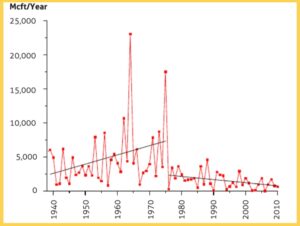
The troubles began.
The dam’s troubles began in the later half of 1970’s. Arkavathi flows into the reservoir decreased by a whopping 83% from 385 MLD pre-1975 to 65 MLD post-2000 as shown in the graph(10).
Bengaluru’s Cauvery Supply: Around the same time, in 1974, approx 135 Million Litres per Day (MLD) of Cauvery river (stage I) water was first supplied to Bengaluru (11).
1979-1999
Real estate developer’s private profits Vs Public’s drinking water security.
1979: District Commissioner (DC) approves the 700-house township, within 2 kms of the reservoir (12).
1982: Alarmed that the reservoir will further deteriorate, BWSSB files a writ petition in the High Court of Karnataka against the DC’s approval (12).
Bengaluru’s Cauvery Supply: Cauvery river water (stage II) provided an additional 135 MLD, totalling 270 MLD supply to Bengaluru (13).
1987: The High court squashes the approvals given to real estate developer, Delhi Land and Finance Universal Ltd (DLF) (12).
1991: DLF revises the proposal by converting the 700-house development to a 200-villa development with a central sewerage system. The state government including BWSSB and Karnataka State Pollution Control Board (KSPCB) approve the revised proposal (12).
This time around, the citizens file Public Interest Litigation challenging the state approval. The high court overturns the state approval (12).
1998: Aggrieved by the Karnataka high court order, DLF approaches Supreme Court. The Supreme Court overturns the Karnataka High Court order giving permission for the township (12).
1999: State government withdraws the permission granted to DLF due to public pressure (14).
1980s

The troubles continued, worsening in fact.
The dam troubles continued into the decade, worsening in fact. The reservoir waters became unreliable as a source of drinking water supply , providing roughly 0 – 25% of its designed supply (14). In a one-off event, the dam filled up to its brim in 1988, which is the only good news (15).
1982 – Bengaluru’s Cauvery Supply: Cauvery river water (stage II) provided an additional 135 MLD, totalling 270 MLD supply to Bengaluru. The loss of Thippagondanahalli waters didn’t really hurt (13).
1990s
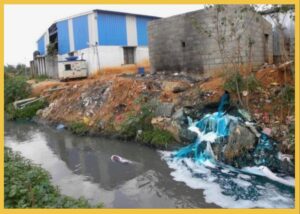
The river dried up. AN END OF AN ERA
While the prolonged battle with real estate developer DLF seemed like a victory, it really wasn’t. The dam catchment had degraded to such an extreme extent, that by the turn of the century, the river had dried up. What remained was the waste-water flow from Bengaluru city. It was an end of an era for Arkavathi.

1992 – Bengaluru’s Cauvery Supply: Cauvery river water (stage III) increased by 270 MLD, totaling 540 MLD supply to Bengaluru (13).
WHAT WE LOST

1792:
Colin Makenzie describes the source of Arkavathi, Nandi Hills (18):
“The stream issues from a metal head, formerly it was said to be of silver; the stream is said to be highly reverenced by the Gentoos; it was cool, and flowed in abundance. The number of venerated origins in these hills is a cause of wonder, but so are the many destinations of waters coming off them.”

1897:
Almost a century ago, Benjamin Lewis Rice described the Arkavathi river in the book ‘Mysore A Gazetteer Compiled for Government; Mysore in General’: “Though never entirely dry, it presents in hot season the usual aspect of a sandy bed with little current of water flowing at one side. In the rains, when the freshes come down, it is a formidable stream, swollen by mountain torrents and bearing along in its irresistible force logs of timber and uprooted trees torn from the forests on its banks.”
WHAT WE GAINED
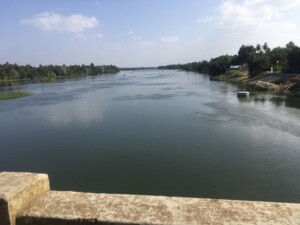
1991-Cauvery Dispute Turns Violent: Violence broke out, for the first time, in Bengaluru and other parts of Karnataka over Cauvery river water sharing with the neighboring state of Tamil Nadu. Tamilians were targeted. While 20 were killed, 50,000 Tamilians fled, and much property was damaged (16). Discontent over water sharing quickly took political, communal, and linguistic overtones, with governments of both states exploiting the situation to their advantage. All this continues till today, in much greater proportions.
1991 was the end of the liberal, cosmopolitan, secular, progressive, and multilingual culture of Bengaluru city. It was the beginning of intolerance, violence, and hatred, logically well-organized for political gains, seemingly over Cauvery water (17).
None of us rose with such anger for Arkavathi and the permanent loss of 3.4 TMC of drinking water. It seems we would rather wrestle it out of Cauvery with much bloodshed, tearing the social fabric and threatening the peace of India’s silicon valley.
1999 – 2003
Indian space research organisation (ISRO) report released.
1999: The state government commissioned Indian space research organization (ISRO) to study the problem of Arkavathi river’s declining flows (14). ISRO’s report “Reduced inflow into TG Halli Reservoir – A Remote Sensing Based Evaluation” recommended (14):
- Declare the entire reservoir catchment as a conservation zone and regulate urbanization/industrialization.
- Declare 10 KM radius of the reservoir as protection zone
- Declare 2 KM buffer zone on either bank of the river
- Prevent alteration of drainage course and impediments to river flow
- Prevent uncontrolled disposal of effluent/sewage
- Control over-exploitation of groundwater
- Implement a proper waste management system.
2002 – Bengaluru’s Cauvery Supply: Cauvery river (stage IV phase 1) water increased by 270 MLD, totaling 810 MLD supply to Bengaluru (13).
Cauvery Water Sharing Dispute: When the Supreme court ordered Karnataka to release Cauvery water to Tamilnadu, protests erupted in the Mandya district of Karnataka. One farmer died, public property was damaged, Bangalore-Mysore highway was blocked (18).
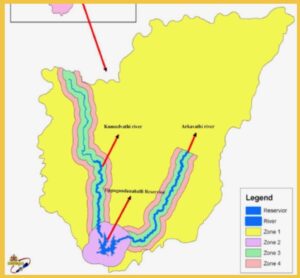
The Thippagondanahalli (TGR) Preservation Notification issued.
18 Nov 2003: Based on ISRO recommendations, the state government issued the TGR (Thippagondanahalli Reservoir) preservation notification (14). It declared the entire catchment as ecologically sensitive, classifying it into four zones and prohibiting activities like industries, quarries, and urbanization (14).
The four zones of preservation notification (14).
- Zone 1:The whole Thippagondanahall Reservoir (TGR) catchment.
- Zone 2: 2 kms from the TGR boundary only agriculture is permitted.
- Zone 3: 1 km distance from river banks. Only agriculture and allied works are permitted.
- Zone 4: A ribbon of 1km distance from Zone 3, only green category industries were permitted. New buildings with only ground and first floor.
2009-2021
Quarry blasting a threat to the dam. Padayatra to revive the river.
Bangalore Water Supply and Sewerage Board (BWSSB) voiced concerns when the seismometer (for measuring earthquakes), set up on the dam premises, recorded vibrations from quarry blasts more than five kms away (19). This sort of blasting held the threat of weakening the structure of the dam.
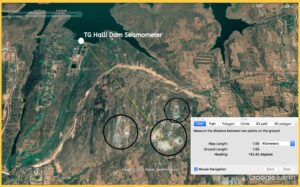
The 2003 TGR preservation notification explicitly prohibits fresh leases or licenses for mining, quarrying, and stone crushing (14). Despite this, around 400 quarries had mushroomed in the catchment with many of them as close as three Kms to the dam (20).
The illegal quarrying continued unabated. In Aug 2021, Samaja Parivarthana Samithi filed a Public Interest Litigation (PIL) in the High Court of Karnataka. The court directed the state government and the Karnataka State Pollution Control Board to conduct monthly checks in the vicinity of the reservoir, to prevent illegal mining, stone quarrying, and crushing operations (21).
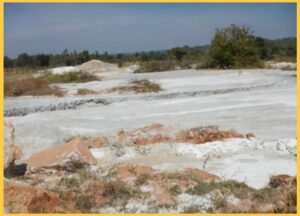
Quarry Pollution.
In 2015, Government’s research organisation Environmental Management & Policy Research Institute (EMPRI) took up a comprehensive study of the reservoir catchment as ordered by Karnataka High Court (WP 38218/2013) (14). The study extensively documented reckless and indiscriminate dumping of toxic quarry waste into the river. One would be hard pressed to find public documentation of toxic pollution of waterbodies from Quarries.
Padayatra to revive the river.
In 2009, while the problems of grave nature remained unaddressed on the ground, padayatra led by BJP Yelahanka MLA S.R Vishwanath (22) to revive the Arkavathi river was undertaken.

The U-turn.
In May 2021, the same Yelahanka MLA who led the padayatra to revive the river opposed the proposal for declaring the Hesaraghatta Grasslands as ‘The Greater Hesaraghatta Grasslands Conservation Reserve’. Saving these grasslands is critical for both Wildlife and Arkavathi river. It is reported that the MLA’s opposition to the Conservation Reserve, led Chief Minister BS Yediyurappa to reject the proposal (23).
Bengaluru’s Cauvery Supply: In 2009, Cauvery river water was increased by another 100 MLD, under Jawaharlal Nehru National Urban Renewal Mission (JNNURM) scheme, totaling 910 MLD of supply to Bengaluru (13).
2010-2022
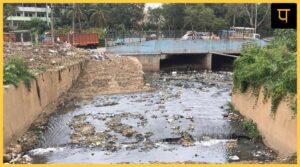
Government of India declares Peenya Industrial Area Severely polluted.
In 2010, the Government of India declared the Peenya Industrial Area, in the drinking water catchment of the Thippagondanahalli dam, to be severely polluted. Despite this, the state government did not take up the issue as a priority to protect drinking water. Instead, found desilting and jungle clearance, an appropriate response as can be seen from 2011 onwards. It was only in 2018 after the NGT passed orders (O.A. No 1038/2018) that Karnataka State Pollution Control Board, was forced to prepare a time-bound action plan to address the issue (24).
The toxic legacy of Hexavalent Chromium in the drinking water catchment.
Hexavalent Chromium, a carcinogen and a reproductive toxicant is found in dangerous quantities in Peenya’s groundwater. (This chemical gained notoriety from the Hollywood movie ‘Erin Brockovich’ played by Julia Roberts). Of the 66 borewells analyzed in 2018, 31 borewells were contaminated with Hexavalent chromium and were sealed (24). In 2013, 20 out of 72 surveyed were contaminated with Hexavalent chromium (25).
No matter what, effluents mixed with sewage and solid waste flow into the reservoir.
Whatever is said and done by KSPCB, the colored industrial effluents mix with sewage and industrial solid waste and flow towards Arkavathi and subsequently to Thippagondanahalli reservoir every day.
2011
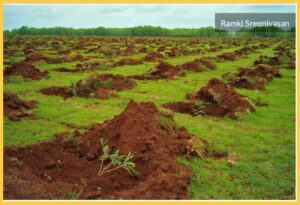
Plantation Threat to Hesaraghatta Grasslands.
The Bangalore Development Authority (BDA), unmindful of the importance of the grassland ecosystem dug about 200 acres of prime grassland with heavy machinery and planted around one lakh saplings. An outcry from conservationists halted the misguided plantation. But the damage to 200 acres of grassland was enormous. In the end, the saplings also didn’t survive (26) (27).
River Rejuvenation Approved.
The state government approved a budget of Rs 22.43 cr to Cauvery Neeravari Nigama Ltd (CNNL) for jungle clearance and de-siltation of river course and its drainage, which it termed ‘Rejuvenation’ (28).
On one hand, is the government’s destruction of 200 acres of dam catchment’s unique Hesarghatta grassland ecosystem. On the other, is the government’s approval of river rejuvenation in the dam catchment.
2012
The reservoir becomes defunct while the river rejuvenation starts.
August 2012: BWSSB stops pumping drinking water from the dam, owing to both quality and quantity concerns (14), (29) (30) (RTI Data obtained by Paani.Earth). After 78 years, Thippagondanahalli Reservoir quietly becomes defunct.
Bengaluru’s Cauvery Supply: The same year, Cauvery river water (stage IV phase 2) increased by a whopping 500 MLD, totaling 1450 MLD of supply to Bengaluru (13). The loss of 3.34 TMC of TGR water was never felt.

Flim city, threat to Hesarghatta Grasslands.
1972: The Government had leased this land to Mysore Film Development Corporation (Now Karnataka Film Development Corporation) back in 1972 to build a film city (29). This was around the time the dam troubles started. However the film city didn’t materialise and the rights of the land were temporarily vested with Kanteerava studios which rented out the area for Kannada film shootings.
By 2012, few people in the Kannada film industry started clamouring for the film city which resulted in the government opening tenders for the detailed project report on developing the area as a film city (29).When the government announced plans to convert the 325-acre unique grasslands into film city, the concerned citizens campaigned to save them. They filed a Public Interest Litigation(PIL) in the Karnataka high court (WP 45759/2012) (29) (30). The PIL went on for 3 years with the government giving an undertaking that they would protect the land till the cabinet decides the fate (29). The 345 acres were given back to the Department of Animal Husbandry and Veterinary Services (29).
River Rejuvenation.
Around the same time, the Chief Minister, Shri D.V Sadananda Gowda launched the Arkavathi river rejuvenation project i.e jungle clearance and de-siltation of river course and its drainage, by offering prayers on the Hesarghatta Lake bed, right next to the grasslands (30) (31).
The river died two decades ago. The reservoir became defunct. Long after this massive loss of 3.34 TMC of drinking water, the rejuvenation efforts boil down to desilting and jungle clearance, not to mention the threat to the grasslands.
2013
Non-implementation of TGR preservation notification.
Ten years after the TGR preservation notification, the state government was pulled up by the high court for not enforcing the notification. As a result, several closure and demolition notices were issued by the state agencies including Bangalore Development Authority(BDA) and Pollution Control Board (33) (34). In response to the government notices, 61 writ petitions were filed in high court from 10 villages (14) (32).
Government party to violations
A survey of 61 writ petitions by state’s own research agency Environmental Management and Policy Research Institute , found some of the litigated godowns on the banks of Arkavathi were constructed under the Central government scheme ‘Grameena Bhandara Yojana’ (32). The godowns had the requisite approvals from Gram Panchayats and loans from nationalized banks (32). In one petition related to 870 houses, some of the houses were built under the government’s scheme ‘Ashraya Yojane’ and ‘Janata Nivas Yojane’(32).
The bill never saw the light of day.
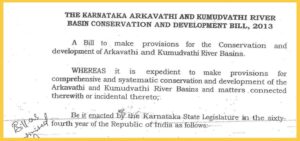
While the massive failure of TGR preservation notification was playing out, the Urban Development Department proposed the creation of a separate authority called “Arkavathi and Kumudvathi River Basin Conservation and Development Authority by framing “The Karnataka Arkavathi and Kumudvathi River Basin Conservation and Development Bill,2013” (14) (35). This act was intended to pave way for effective implementation of the 2003 TGR preservation notification. This would have been a game-changer. Sadly, it never saw the light of day.
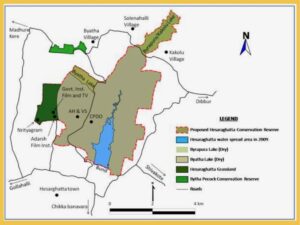
Citizens Hesaraghatta Grasslands Conservation Proposal.
In 2013, The concerned citizens submitted a detailed proposal to the Karnataka Forest Department to declare 5000 acres of Hesaraghatta land including the lakebed as a ‘conservation reserve’ under section 36A of the Wildlife Protection Act (36).
2014
The Government tries to withdraw TGR preservation notification.
- The government withdraws notification.
On 24 July 2014, roughly ten years after the Thippagondanahalli Reservoir (TGR) Preservation Notification was issued in 2003, the Karnataka state government withdrew the notification with the objective of taking stock of the situation and issuing a fresh one (14). - The High Court stays withdrawing.
The High Court of Karnataka refuses the withdrawal of TGR preservation notification observing that the withdrawal is not in the public interest and passes an interim stay order (WP No 38218/2013) (14) (37) . - The High Court observes government collusion with private interests.
The court observes that the government may have colluded with those who constructed the structures violating the norms of TGR preservation notification (38). It says,“ You [Government] choke your own river. Thereafter you spend Rs 2,000 crore to bring to the city water from the Cauvery and the Krishna. Is this public service? Is this why the power is delegated to state government?” (38). - The court’s observations proved correct. A few years later in 2019, the government approved a project to fill Chamarajasagara Dam with Netravathi river water from 280kms away via Yettinahole drinking water project.
- The government withdraws notification.
A non-governmental effort to revive the dam catchment.
Between 2014-2016, the International Association for Human Values (IAHV), a sister organization of the Art of Living(AOL) executed what they called ‘Kumudvathi Rejuvenation’ with a Corporate Social Responsibility fund of Rs 4.77 cr from Hindustan Aeronautical Limited (39). This was the first non-governmental effort to revive the river with a huge financial outlay. The work done as part of rejuvenation: Recharging of wells (202), boulder checks (202), Injection Borewells (27), Water-pools (35), and planting of saplings (15000).
2015
Staying the TGR Preservation notification withdrawal, the High court orders a comprehensive study.
Staying the government’s withdrawal of the TGR Preservation notification, Karnataka High Court (WP 38218/2013) entrusted Government’s research organization Environmental Management & Policy Research Institute (EMPRI) to take up a comprehensive study of the catchment (14). The study recommended:
- “The Karnataka Arkavathi and Kumudvathi River Basin Conservation and Development Bill,2013” proposed by UDD, with suitable modifications, if any, must be enacted and implemented.
Continuous monitoring and removal of unauthorized obstructions - Stopping of Illegal Quarrying, Soil excavation and Sand Mining.
- Karnataka Tank Conservation and Development Authority Act, 2014 must be implemented effectively
- As per the high court order in writ petition No 817/2008, all the feeder tanks coming under the TGR Catchment should be surveyed, demarcated and fenced.
- Control of industrial effluent discharge
- Management of solid waste
- Preservation and maintenance of storm water drains
- Regulation and management of ground water
- Adoption of rain water harvesting system
- Tree plantation along river stretches
- Implementation of the existing conservation zone till the formation of the river basin authority and prevention of change in land use pattern
- “The Karnataka Arkavathi and Kumudvathi River Basin Conservation and Development Bill,2013” proposed by UDD, with suitable modifications, if any, must be enacted and implemented.
Arkavathi’s baseflow decline was primarily due to groundwater exploitation.
The same year Bengaluru based Ashoka Trust for Research in Ecology and Environment’s preliminary analysis found, Arkavathi’s baseflow decline was primarily due to groundwater exploitation (40).
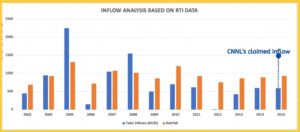
The government claims river rejuvenation a success. RTI Data refutes the claim.
Cauvery Neeravari Nigama Ltd (CNNL) claimed their rejuvenation efforts (i.e desilting and jungle clearance) to be successful: the dam received about 40-45 ft (1.5 TMC) of water (14).
Thippagondanahalli inflow data obtained by us via RTI revealed that the dam did not receive any inflows amounting to 1500 Mcft (1.5 TMC) in 2015 or any year during the rejuvenation.
Comptroller Auditor General’s (CAG) says river rejuvenation, as was done, was detrimental.
2018: CAG threw light on how some of the activities were not undertaken. The report said: As a result of not ensuring the site conditions and non-inclusion of work of removal of liquid waste effected the quality of water flowing in the stream and was detrimental to the rejuvenation of the river flows (41).
In short, no concrete action was taken up for the protection of the drinking water catchment despite the underlying causes being very clear.
2017
The reservoir was just two feet short of attaining FRL, but the the water remains unused.
This was the year the rainfall records were broken as per the rain gauge located on the dam premises (42):
- The TGR catchment received the highest rainfall ever at 1615.2mm, breaking the 2005 record of 1606.8mm
- The one-day rainfall recorded as 184mm in August 2017 was the highest ever, breaking the 27th Aug 1980 record of 162.1mm.
The reservoir received significant inflows. By the end of oct, the reservoir was just two feet short of attaining FRL. However the water remained unused(4). Additionally, one of the sluice gates was leaking since 2014 (14) and it continued into 2017, as verified by us during ground survey. Due to the leaky gate, Manchanabele dam, 10 kms downstream, started to get significant inflows.
Cauvery River Dispute: A year before in 2016, violence erupted in Karnataka over court orders to release Cauvery water to Tamil Nadu. 30 buses were set ablaze in Bengaluru city. The city police has clamped prohibitory orders under Section 144 of the Criminal Procedure Code (43).
2018
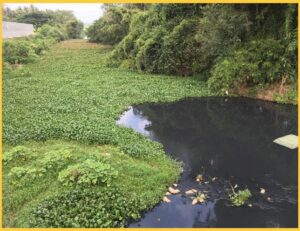
Thippagondanahalli reservoir severely polluted.
Central Pollution Control Board declared the 55 km Arkavathi river stretch from Thippagondanahalli reservoir to Kanakapura town to be severely polluted (44). Action plans were prepared to address the pollution issues (45) . However, the action plan did not address the pollution of the reservoir.
Industrial effluents, sewage, and solid waste are the main polluters. It must be noted that the Bengaluru Water Supply and Sewerage Board (BWSSB) the custodian of the reservoir is also responsible for failed sewerage system resulting in the flow of sewage into the reservoir.
Bengaluru’s Cauvery Supply: In the same year, BWSSB’s project Cauvery stage V which is to supply an additional 750 MLD to Bengaluru (a process that started in 2014) got funding from JICA (46) (47). With this Bengaluru will be receiving 2150 MLD of Cauvery water. The project is scheduled to be completed in 2022.
Cauvery River Dispute: Supreme court increased Karnataka’s Cauvery river water share of 270 TMC, by 14.75 TMC, totaling 184.75 TMC. It designated 4.75 TMC of the newly allocated 14.75 TMC for Bengaluru’s drinking water requirements (48).
2019

TGR preservation notification diluted.
In a big blow to the protection of the reservoir’s catchment, the government giving in to special interests ignored all the recommendations made by expert groups in the past two decades and diluted the 2003 Thippagondanahalli Reservoir Preservation Notification, by reducing the river bank buffer zones by half (49) (50). The decision was made in the meeting chaired by deputy chief minister G Parameshwara, days before the government fell (49) (50).
- Zone 1: No change
- Zone 2: No change
- Zone 3: Protected area of 1 km from the river bank, reduced to 500 Meters.
- Zone 4: Protection area between 1 km and 2 km distance from the river bank is reduced to an area between 500 meters to 1 km.
Nandi Ecosystem Conservation and Development Authority(53).
In the same year (2019), Bangalore Environment Trust (BET) along with National Law School India University released ‘Report on the conservation and sustainability of Nandi Hill Ecosystem’ to lobby the government for the protection of the Nandi hill ecosystem, the origin of Arkavathi and Dakshina Pinakini River (51). The report proposed the creation of the ‘Nandi Ecosystem Conservation and Development Authority”, a single, independent and autonomous body. As of today, BET continues to lobby the government.
2019-2022
RIVER SWITCH: FROM ARKAVATHI TO NETRAVATHI.
Having exhausted/exploited Arkavathi river water, the government announced plans to restore the dam to receive 1.8 TMC of waters from the west-flowing Netravathi river, 280 km away, from the Yettinahole Drinking Water project (52). Even Hesaraghatta reservoir is slated to receive 0.7 TMC of Netravathi waters (52).
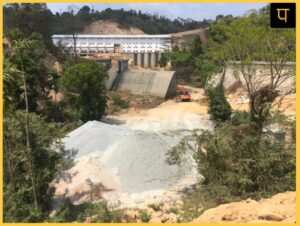
Yettinahole Integrated Drinking Water Project.
Externally funded by Japan International Cooperation Agency (JICA) (53), Yettinahole Integrated Drinking Water Project is a major inter-basin river water transfer from Netravathi Basin 280 kms away to Arkavathi, Shimsha, and Dakshina Pinakini Basin.
The project intents to provide 24 TMC of water to the parched districts of South Karnataka by filling 527 Minor irrigation tanks (54), with 873 kilometers of pipeline denuding 600 acres of forest, with 8 dams that will submerge 1,200 hectares of land (55). It will require 370 Megawatts of electricity to pump water (55).
The project today has doubled in cost to Rs 25,000 Cr (56) while creating a massive ecological and humanitarian crisis in the villages of ecologically fragile western ghats (55).
It is to be seen how much water actually materializes as the experts have repeatedly asserted that there is insufficient water in the Netravathi catchment. While the government DPR estimates 24 TMC, the scientific calculations show 9.55 TMC (of which local demand is 5.84 and e-flow needed to sustain the ecosystem is 2.86) (57).
Dam rejuvenation is in progress.
The 2022-23 state budget allocated Rs 312 Cr for the rejuvenation of Tippagondanahalli Reservoir from the ‘Mega City Revolving Fund’ (58). Thippagondanahalli rejuvenation works include desilting, 20 MLD Sewage Treatment Plant along with a treated sewage pumping station, 110 MLD drinking water treatment plant, fencing and other repair works of the dam (59). The work is to be completed in the year 2022-23.
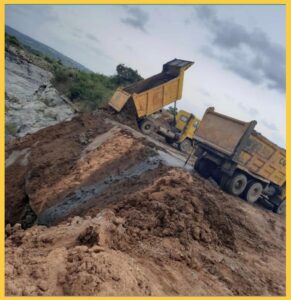
Hazardous reservoir silt dumped into abandoned quarries.
2020: Tests have revealed that the reservoir silt is toxic in nature owing to high levels of heavy metals like Arsenic and Lead (60). This indicates that the water stored in the reservoir was polluted with heavy metals.
As part of rejuvenation, reservoir desilting work is taken up at the cost of 22.7 crores (59). The hazardous silt is now dumped into abandoned quarries. As shown in the image, the quarries have no lining/protection showing improper disposal of hazardous waste. This has a huge potential to cause groundwater contamination.
Cauvery Water dispute to Mekedatu Dam: Since the 2018 court allocation of 4.75 TMC, the calls to build the controversial 64-TMC Mekedatu balancing reservoir on the Cauvery river have reverberated. In 2019, the Karnataka state government tried to get Environmental Clearance for the project, which currently is in deferred status (61). In Jan-Mar 2022, congress made a spectacle by launching a 165-km padayatra, unmindful of the pandemic, seeking implementation of the Mekedatu balancing reservoir (62).
All this to exploit the ailing Cauvery, while the protection and conservation itself is completely neglected and opposed (non-implementation of Kasturirangan committee report to protect Western Ghats, which is Cauvery’s water tower). The story seems eerily similar to Arkavathi.
The history of the Thippagondahalli dam helps us understand, so very clearly, that dams do not mean more water. Rivers that flow do.
Thippagondahalli dam on Arkavathi river stands as a living testimony to that.
We could either protect and conserve Cauvery, or exploit every drop of her until she goes the Arkavathi way.

RIVER BASIN

DAMS & FLOW

POLLUTION

GROUNDWATER

STRAWS

RAINFALL FLOODS & DROUGHT

RESTORATION




